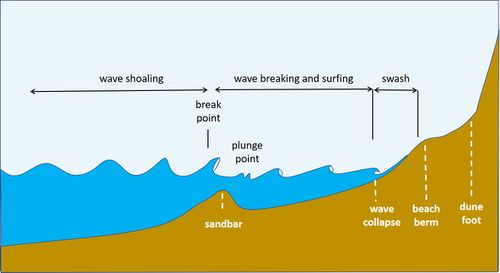Difference between revisions of "Surf zone"
From Coastal Wiki
Tasomerville (talk | contribs) m |
Dronkers J (talk | contribs) |
||
| (4 intermediate revisions by the same user not shown) | |||
| Line 1: | Line 1: | ||
{{ | {{ | ||
| − | Definition|title=Surf zone | + | Definition|title=Surf zone or Breaker zone |
| − | |definition= The zone of wave | + | |definition= The surf zone (or '''breaker zone''') is the zone where waves break as a consequence of depth limitation and surf onshore as wave bores.}} |
| + | |||
| + | |||
| + | ==Notes== | ||
| + | The width of the surf zone varies depending on the wave conditions and water level. The surf zone is narrow and close to the shoreline in a gentle wave climate and can be very wide under storm conditions, extending from the seaward boundary of the upper shoreface to the dunefoot. It is estimated that 80 to 90% of the yearly littoral transport takes place within the breaker or surf zone. | ||
| + | |||
| + | |||
| + | [[File:WaveTransformation.jpg|thumb|500px|center|Wave transformation in the nearshore zone.]] | ||
| − | |||
| − | |||
==See also== | ==See also== | ||
| − | + | :[[Shoreface profile]] | |
| − | + | :[[Breaker index]] | |
| − | + | :[[Wave transformation]] | |
| − | + | :[[Shallow-water wave theory]] | |
| − | |||
Latest revision as of 11:57, 12 April 2022
Definition of Surf zone or Breaker zone:
The surf zone (or breaker zone) is the zone where waves break as a consequence of depth limitation and surf onshore as wave bores.
This is the common definition for Surf zone or Breaker zone, other definitions can be discussed in the article
|
Notes
The width of the surf zone varies depending on the wave conditions and water level. The surf zone is narrow and close to the shoreline in a gentle wave climate and can be very wide under storm conditions, extending from the seaward boundary of the upper shoreface to the dunefoot. It is estimated that 80 to 90% of the yearly littoral transport takes place within the breaker or surf zone.
